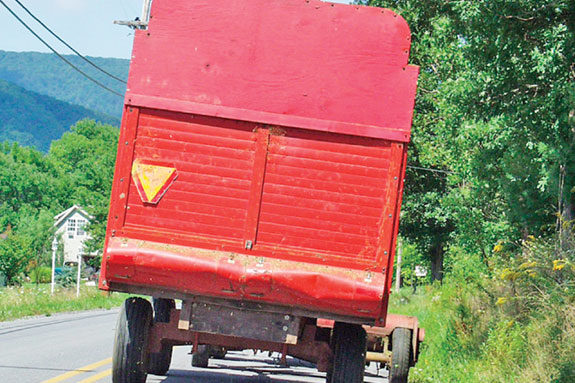Safety with these machines can best be discussed by identifying the four major hazard areas associated with this equipment.
These are the power take-off (PTO) (except on self-propelled units), the cutterbar or swinging knives, crimping or crushing rolls and gathering reels.
Mowers and mower-conditioners are usually powered by PTO shafts. Keep the tractor’s master shield and the machine’s PTO shield in place and in good operating condition. Driveline shafts should spin freely when the machine is not operating.
In particular, many old sicklebar mowers have unguarded PTO shafts with little or no shielding of other rotating or moving parts.
Lessen your chances of becoming caught by exposed shafts by making sure you don’t step next to a rotating shaft to get on or off the tractor. Better yet, guard it!
Cutterbar accidents usually involve severe lacerations or amputations, particularly to the fingers and toes. These accidents happen when the cutterbar plugs up in the field or during maintenance or servicing.
To safely unplug the cutterbar, follow these steps: Stop and disengage the PTO, raise the cutterbar and back up a few feet.
Shut off the tractor and shift into park or set the brakes, then pull hay away from the cutterbar with gloved hands.
Check the cutterbar for broken guards or knife sections, start the engine and engage the PTO at low speed, lower the cutterbar, ease mower into standing hay and resume operation.
If a knife section has to be replaced, handle the blade bar only from the rear side. If you can remove the sicklebar by yourself, do so. Numerous injuries have occurred when two people did not adequately coordinate their movements.
Reels and tines are an additional hazard on some conditioners and mower-conditioners. The reels help deliver the crop to the crimping rolls.
Farmers have been hit in the head by rotating reels as they bend over either in front of or behind the reel to clear plugs of the crop. And they have been pulled into the reel when tines have caught hands or clothing.
The obvious way to avoid these injuries is to disengage the PTO and make sure all movement has stopped before cleaning or servicing the machine.
Conditioners and mower-conditioners use crimping or crushing rolls to condition hay so it dries more quickly. The rolls are PTO-powered and pull the hay between them and throw it out of the back of the machine.
Small stones, pieces of metal or wire can be picked up and hurled backward with enough force to penetrate the skin or destroy an eye, so don’t let anyone walk behind the machine while in operation.
Also, avoid reaching into the front of the crimping rolls to brush away plugs or debris; a hand and arm could be pulled between the crimping rolls before you even realize you’re caught.
Depending on the type of machine, the crop may or may not be left in a windrow. If it is not, then the crop will have to be raked.
Rakes are not particularly hazardous because they aren’t operating unless the farmer is on the tractor and moving down the field.
However, serious injuries and fatalities occasionally occur because operators or extra riders fall off tractors and are run over by either the tractor or the rake.
Hay fields are likely spots for groundhog holes and the jarring action they cause when a wheel drops into one can cause the operator to lose control of the tractor and be thrown out of the seat.
Avoid this type of tragedy by refusing to carry extra riders, searching out and marking holes before field operation and by wearing the tractor’s seat belt, if one is provided.
Additionally, if you can’t go around a groundhog hole, shift down to a lower gear and ease the tractor over it.
Self-propelled windrowers mow, condition and windrow hay in one trip over the field. The speed at which you operate your windrower can play a large part in accident prevention. Too high a speed will cause frequent plugging.
The more often you must unplug your machine, the higher the chances of an accident. Matching your machine’s speed to the crop condition and the terrain will generally save you time. Frequent stops to clear the machine usually consume more time than steady harvesting at a slower speed.
Forage-chopping machines have numerous familiar hazards, such as rotating shafts, gears, chains and belts. Perhaps the most important thing for forage harvester operators to remember is that their machine is designed to gather in the crop and then chop it into fine pieces so that it can be blown into a trailing wagon.
This requires sharp knives operating at high speeds. If your arm or leg is drawn into the machine, then it will be treated exactly as if it were a stalk of corn or a swath of hay.
Most forage harvesters have a built-in knife sharpener. Some sharpeners require shields to be removed in order to operate.
Wear eye protection and keep your hands, arms and head away from the opening. Also, make sure that nothing can fall into the knives. If you must repair or replace knives, block the cylinder cutterhead so it doesn’t move unexpectedly.
Because the knives are free-wheeling and continue to rotate after the power has been shut off, it’s tempting to insert sticks and broom handles into the knives to bring them to a quick stop.
Not only can your hands be jerked into the knives by this practice, but chips or chunks of wood can be thrown back at you. Always let the knives come to a full stop on their own.
If you have safely harvested your crop from the field, transporting it back to the farmstead is no time to let your guard down. Always use properly sized safety drawbar pins.
Make sure the tractor is large enough to handle the weight of the load on hills, that the tractor brakes are in good condition and properly adjusted and that the tractor operator has enough experience to operate a tractor with a heavy load on public roadways.
If you must haul a heavy load on public roadways, attach a safety chain between the tractor and the wagon. A slow-moving-vehicle (SMV) emblem is required by law in many places. This must be placed on the back of the silo wagon.
Don’t let the emblem become so faded that it can’t do its intended job. If your tractor has flashing lights, use them, and also use hand signals as appropriate.
In many cases, it may be well worth the time and effort to arrange for another vehicle to follow the tractor operator while on the roadway.
This would be a particularly good idea in times of poor visibility, with less experienced tractor operators or when you are hauling two wagons. Make every effort to stay off roadways after dusk. FG
—Excerpts from Penn State Cooperative Extension Agricultural and Biological Engineering newsletter
PHOTO
TOP RIGHT: A slow-moving-vehicle (SMV) emblem is required by law in many places. Photo courtesy of Penn State Cooperative Extension Agricultural and Biological Engineering newsletter.










